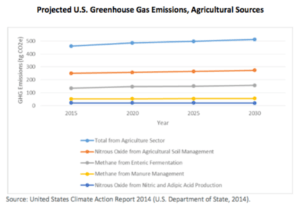Monsanto: Problem Solver or Problem Creator?

An overview of Monsanto's impact on the environment and steps the company is taking to make a difference.
Monsanto Overview
Monsanto is a publicly traded American agriculture company that provides products for farmers across the globe. Its two main segments are Seeds & Genomics and Agricultural Productivity. The Seeds & Genomics division produces a huge array of different types of crop seeds, many of which are genetically modified (“GMOs”). The Agricultural Prod uctivity segment makes herbicides for various end-users. Examples of the company’s products can be seen in the visual on the right1. Monsanto, whose history dates back to 1901, is one of the largest suppliers to the food industry with $13.5 billion in revenue in Fiscal Year 2016. Given their strong market position and emphasis on genetically modified seeds, Monsanto has been a source of much controversy in government affairs, the agricultural landscape, and the public as a whole.
uctivity segment makes herbicides for various end-users. Examples of the company’s products can be seen in the visual on the right1. Monsanto, whose history dates back to 1901, is one of the largest suppliers to the food industry with $13.5 billion in revenue in Fiscal Year 2016. Given their strong market position and emphasis on genetically modified seeds, Monsanto has been a source of much controversy in government affairs, the agricultural landscape, and the public as a whole.
Agriculture and the Environment
Global warming will have a significant impact on many aspects in the agriculture ecosystem. While some of the current varieties of crops may thrive in a changing climate, others may be much less successful, leaving producers with no choice but to develop crops more rsistant to rising temperatures and changing rainfall patterns. Global warming has been a leading motivator for GMOs as producers try to leverage genetic traits from outside resources to create certain new, climate-resistant varieties of crops. However, without public intervention, it seems that the research into GMOs will not reach optimal levels as companies can only profit during their proprietary research process. This inherent problem has led to the conclusion “among both public and private-sector institutions that the public sector has an important role to play in crucial stages of crop genetic conservation and improvement if the best results for society as a whole are to be achieved.”2 While the agriculture industry is being impacted by climate change, they are also one of the main culprits, with “24% of global Greenhouse Gas emissions from deforestation ad agricultural emissions from livestock, soil, and nutrient management.“3 The graph below displays a breakdown of projected U.S. Greenhouse Gas emissions from agriculture.4
Monsanto’s Response
Monsanto has taken many steps to get out in front of the impacts of global warming. The company has produced hybrid seeds that can adapt to a wider range of climates and drought levels. They have also done analysis on nitrogen use (one of the main greenhouse gases com ing from agriculture as shown above) which they are attempting to bring down over time. David Fischhoff, technology strategy and development lead for Monsanto, explains that “Monsanto’s nitrogen-use trait should help maintain high grain yield at lower nitrogen levels and could contribute to a significant reduction of agricultural gr eenhouse gas emissions.”5 Monsanto offers vast resources to their farmers to encourage the use of best practices for crop management that will reduce negative impact on the climate. Most recently, “in December 2015, Monsanto announced a first-of-it-kind program to introduce a model for carbon neutral crop production that will help reduce the carbon footprint of crop production.” See the visual on the right for a full summary of the production plan.6
eenhouse gas emissions.”5 Monsanto offers vast resources to their farmers to encourage the use of best practices for crop management that will reduce negative impact on the climate. Most recently, “in December 2015, Monsanto announced a first-of-it-kind program to introduce a model for carbon neutral crop production that will help reduce the carbon footprint of crop production.” See the visual on the right for a full summary of the production plan.6
Next Steps
There are three main steps that Monsanto can take to assure their own future corporate success and to help the planet fight off global warming: reduce their emissions (particularly in nitrogen), researching crops that can endure a new climate, and help farmers incorporate more green-friendly best practices.
- Since the majority of the company’s Greenhouse Gas emissions come from their Agricultural Productivity business line, I believe they should re-focus their R&D investment into new, more energy efficient crop protectors. While this initiative is certainly an expensive investment, it will signal to the entire agricultural market that Monsanto is serious about protecting the environment. The company spent over $1.5 billion on R&D in Fiscal Year 2016, but this was mostly dedicated to GMOs for the Seeds & Genomics division; a shift in capital allocation will give Monsanto the resources to make a difference.
- Monsanto must deeply consider its future prospects on a new, warmer planet. The company is world-class at creating GMOs, but they are typically focused on seeds that are resistant to herbicide and pathogens. Moving forward, the company should increase their development of seeds that can thrive in a wide array of potential future climates.
- As an industry leader, Monsanto can have heavy influence on other members of the supply chain. I believe the company should increase their investment in programs that encourage farmers and provides incentives for greener methodologies. Monsanto should also continue to assist farmers by investing in their programs which “develop greener techniques that let the soil hold on to more greenhouse gases, instead of releasing them back into the atmosphere”7.
https://www.youtube.com/watch?v=y3F-XSfojd0
(773 Words)
Sources:
1: Monsanto. (3, November 2016). Monsanto Brands. Retrieved from http://www.monsanto.com/products/pages/monsanto-product-brands.aspx.
2: Heisey, Paul W., and Kelly Day Rubenstein. Using Crop Genetic Resources To Help Agriculture Adapt to Climate Change: Economics and Policy, EIB-139, U.S. Department of Agriculture, Economic Research Service, April 2015.
3,4: ICF International. June 2016. Charting a Path to Carbon Neutral Agriculture, Prepared by ICF International. Retrieved from http://www.monsanto.com/improvingagriculture/documents/climate%20change/icfreportchartingapath-%20june102016.pdf.
5: Hest, D. (2008). Seeds for global warming. Farm Industry News, 41(1), 75-78. Retrieved from http://search.proquest.com.ezp-prod1.hul.harvard.edu/docview/229796426?accountid=11311
6: Monsanto. (3, November 2016). Advancing Products and Practices to Fight Climate Change. Retrieved from http://www.monsanto.com/improvingagriculture/pages/carbon-neutral-crop-production.aspx.
7: Jackson, M. (2015, Dec 01). Can Monsanto lead way to carbon neutral farming? The Christian Science Monitor Retrieved from http://search.proquest.com.ezp-prod1.hul.harvard.edu/docview/1738051873?accountid=11311



Zach, this was super interesting. You usually see Monsanto vilified by the anti-GMO crowd. It’s interesting seeing them taking measures to combat climate change and develop sustainable food practices. At the same time, you mentioned that the majority of their emissions come from their Agricultural Productivity line which, I think, is a euphemism for pesticides and herbicides. Have they committed any R&D to developing more environmentally friendly agricultural chemicals as you suggest?
Thanks for this Zach. I’m interested in whether you think that Monsanto has contributed to a loss of genetic diversity (or as the WWF refer to it ‘genetic erosion’, see http://wwf.panda.org/what_we_do/footprint/agriculture/impacts/genetic_erosion). Crops have lost 75% of their genetic diversity over the last century, largely due to the use of genetically uniform crops. On the one hand, Monsanto is clearly intensively researching new resilient GMO crops, but have Monsanto and companies like it contributed to the need for these resilient crops by undermining the natural diversity that existed before their pursuit of high yield, low intensity varieties?
I agree that Monsanto should invest in other types of R&D to address the changing climate. I find the development of these seeds to be similar to the drug industry in that there is significant upfront costs. With pharmaceuticals, these costs can be recouped with higher pricing and an opaque payment system. However, in the case of Monsanto, do you think there is a limit to how much value can be driven from farming companies which I imagine already run on low margins.
I’m curious to hear what are the greener methodologies farmers can use to help trap more greenhouse gases within the soil. Also, why hasn’t Monsanto already worked on seeds that can survive in harsher climates. It this because working on seeds resistant to herbicides/pathogens is more technologically feasible and more profitable?
Zach, love your choice of topic in Monsanto – for many of the reasons you outline early in the article, namely its size, potential for global environmental impact, and the controversial nature of its history. I appreciated the focus of your article on both the climate impact of agriculture (through methods like nitrogen release) and on the changing global climate as a threat to available farmable land and crop resistance to changing climate trends. I wonder which of these you see as more important, and the relative importance of Monsanto in each area?
Zach, thanks so much for your informative piece on Monsanto. It is indeed one of the most vilified companies out there. The carbon neutral crop production plan that the company developed is certainly innovative, and leverages some of Monsanto’s key strengths of thinking outside the box and taking agriculture where others have not.
The controversy around GMOs has always been interesting to me because the science behind GMOs is actually quite sound. Monsanto decided to be rather sneaky and not release much (any) information on what genetic modification was and why they were doing, and this is what led to public backlash, and why even to this day GMOs are vehemently contested for their safety. I wonder whether Monsanto learned a lesson here, or if they will continue to be less than forthright with product development, but that is neither here nor there.
I agree with many of your suggestions, but I do question the moral responsibility Monsanto has in shifting R&D dollars towards more sustainable (disease/drought tolerant) seeds. I, too, wish the company would take the lead here and signal to the market that they are serious about the environment – but is that best for business? Monsanto has done a fantastic job of setting precedent for strong intellectual property defense of their GMO and Seed & Genomics business, and it has become the company’s cash cow. At this point in time when M&A is at an all-time high in agribusiness, and considering the Bayer-Monsanto acquisition is seeming more certain, I can’t help but question what incentive the Monsanto (or Bayer) would have to reallocate these precious R&D dollars, and I can’t even bring myself to say it is their ethical responsibility to do so.
It’s an interesting question to wrestle with – thanks for sharing these thoughts!